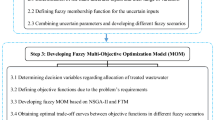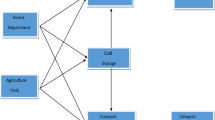Abstract
With rising industrial ESG needs, companies must optimize their effluent treatment plant design to reduce carbon emissions and meet government regulations. Industrial decision-makers face challenges in selecting the best effluent treatment technology that meets all goals and regulations. By considering the energy usage of various technological combinations, a model is created to minimize the carbon footprint. Fuzzy optimization modelling and carbon footprint integration result in more effective and sustainable industrial effluent treatment systems. In the future, the multi-objective optimization will be considered to balance environmental sustainability and practicality.
Access this chapter
Tax calculation will be finalised at checkout
Purchases are for personal use only
Similar content being viewed by others
References
Department of Environment: Environmental quality (sewage) regulations. Ministry of Environment and Water (PU(A) 432) (2009)
Ho, J.Y., Wan, Y.K., Andiappan, V., Ng, D.K.S.: Material flow cost account-based approach for synthesis and optimisation of wastewater treatment plant. Chem. Eng. Trans. 76, 529–534 (2019). Available at: https://doi.org/10.3303/CET1976089
Ho, J.Y., Ooi, J., Wan, Y.K., Andiappan, V.: Synthesis of a sustainable effluent treatment plant for sago industry using fuzzy optimization. Chem. Eng. Trans. 83, 373–378 (2021)
Von Sperling, M., Verbyla, M.E., Oliveira, S.M.: Assessment of Treatment Plant Performance and Water Quality Data: A Guide for Students, Researchers and Practitioners. IWA publishing (2020)
Department of Energy: Benchmark model for wastewater treatment using an activated sludge process (2022). Available at: https://catalog.data.gov/dataset/benchmark-model-for-wastewater-treatment-using-an-activated-sludge-process
Author information
Authors and Affiliations
Corresponding author
Editor information
Editors and Affiliations
Rights and permissions
Copyright information
© 2023 The Author(s), under exclusive license to Springer Nature Switzerland AG
About this paper
Cite this paper
Yeoh, K.T.K., Choo, C.M., Jamaluddin, M.F., Lim, G.Y., Chew, J.H., Ng, L.Y. (2023). Carbon Footprint Optimization for Efficient Effluent Treatment Selection by Using Fuzzy Optimization Modelling. In: Vasant, P., et al. Intelligent Computing and Optimization. ICO 2023. Lecture Notes in Networks and Systems, vol 854. Springer, Cham. https://doi.org/10.1007/978-3-031-50151-7_6
Download citation
DOI: https://doi.org/10.1007/978-3-031-50151-7_6
Published:
Publisher Name: Springer, Cham
Print ISBN: 978-3-031-50150-0
Online ISBN: 978-3-031-50151-7
eBook Packages: Intelligent Technologies and RoboticsIntelligent Technologies and Robotics (R0)




